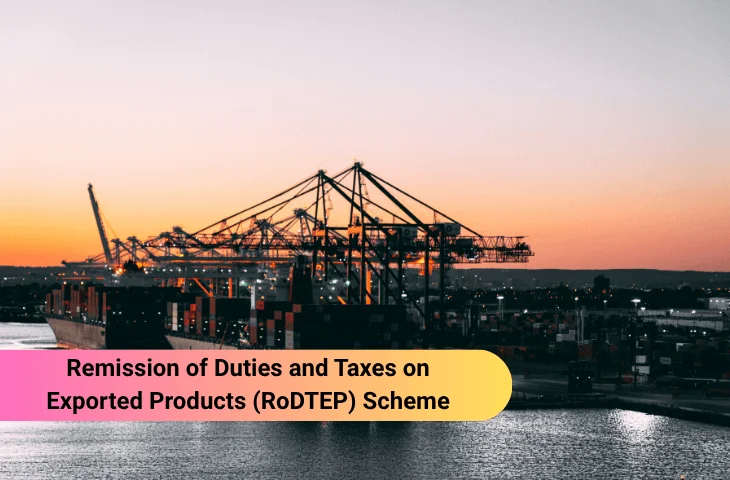The Remission of Duties and Taxes on Exported Products (RoDTEP) Scheme is an Indian government initiative. It aims to reimburse exporters for duties, taxes, and levies embedded in the production of exported goods, which are not refunded under other existing schemes.
The scheme was launched on 1st January 2021, RoDTEP replaced the earlier Merchandise Exports from India Scheme (MEIS) following challenges at the World Trade Organization (WTO). The MEIS was criticized for being inconsistent with international trade rules, prompting India to develop a compliant mechanism to continue supporting its exporters.
The scheme is fully digital and transparent, using an end-to-end IT platform managed by the Central Board of Indirect Taxes and Customs (CBIC) to track and credit eligible rebates.
Why was the RoDTEP Scheme Introduced?
The primary motivation behind RoDTEP was to boost the competitiveness of Indian exports while ensuring compliance with WTO rules.
- The United States and other countries challenged India’s previous export subsidy programs like MEIS at the WTO.
- The WTO ruled that these subsidies violated global trade norms, requiring India to restructure its export incentive mechanisms.
- RoDTEP was designed to neutralize all embedded taxes and duties on exported goods without violating international trade rules.
In essence, the scheme ensures that Indian exporters are not at a disadvantage due to domestic taxes like VAT on fuel, mandi tax, and excise duties, which are not recoverable under other schemes.
How does the RoDTEP Scheme Work?
RoDTEP provides rebates in the form of electronic scrips (e-scrips). These e-scrips are transferable duty credits maintained in an electronic ledger and can be used for:
- Payment of basic customs duty on imports
- Transfer to other importers if needed
The rebate rates are specific to products, classified by their 8-digit HS codes, and are notified periodically by the government.
The scheme is structured to cover all embedded central, state, and local taxes and levies that are not refunded under other mechanisms.
- Fully digital and automated system for credit issuance and verification
- Applies to all sectors, with priority for labor-intensive industries
- No turnover threshold for eligibility
- Coverage includes goods exported via e-commerce platforms and courier services
Check Out: Complete List of Important Schemes for NABARD Grade A Exam
Who is Eligible for RoDTEP Benefits?
The scheme is inclusive, allowing a wide range of exporters to claim benefits:
- Manufacturer exporters and merchant exporters (traders)
- Exporters operating under Special Economic Zones (SEZs) and Export Oriented Units (EOUs)
- Products must have India as the country of origin
- Re-exported products are not eligible
The scheme also prioritizes sectors previously benefitting under MEIS, ensuring continuity of support for labor-intensive industries like textiles.
What Taxes and Duties are Covered Under RoDTEP?
RoDTEP reimburses embedded taxes and levies that are not refunded under other schemes. These include:
- Mandi Tax
- State VAT on fuel
- Central Excise Duty on inputs like fuel
- Electricity duty
- Other local levies embedded in production
By refunding these indirect taxes, the scheme reduces the overall cost of exports, making Indian products more competitive internationally.
Get ready to crack government job exams with leading educators
How are RoDTEP Benefits Claimed?
Eligible exporters can claim RoDTEP benefits using a digital platform managed by CBIC, which offers:
- Electronic credit ledger to manage e-scrips
- Automated verification and audit system for quick approval
- Monitoring through IT-based risk management systems to prevent misuse
Rebates are calculated as a percentage of the Freight on Board (FOB) value of exported goods.
How has RoDTEP Evolved Over Time?
Since its inception in 2021, RoDTEP has undergone several enhancements:
- Extension of benefits for AA holders, EOUs, and SEZ units (effective from June 2025)
- Total disbursements exceeded Rs 57,976 crore as of March 2025
- Priority to labor-intensive sectors to support employment and export growth
- Improved digitalization to ensure faster processing and transparency
These measures aim to provide a level playing field for all exporters, particularly after temporary suspensions earlier in 2025.
What Challenges Exist in RoDTEP Implementation?
Despite its advantages, the scheme faces certain challenges:
- Documentation Issues: Exporters sometimes struggle to provide detailed records of taxes paid, particularly for inputs like fuel where bills may not segregate central and state levies.
- Countervailing Duties: Some countries, including the US and EU, have imposed anti-subsidy duties on Indian products, questioning the legitimacy of RoDTEP benefits.
- Awareness and Training: Small exporters may not be fully aware of procedures for claiming rebates, requiring proper training and guidance.
Also Check: List of Government Schemes of India
How does RoDTEP Benefit Exporters and the Economy?
RoDTEP offers direct and indirect advantages for both exporters and the Indian economy:
For Exporters:
- Reduces export costs by refunding hidden taxes and levies
- Improves international competitiveness
- Enhances access to global markets
- Encourages digital compliance and record-keeping
For the Economy:
- Boosts overall export volumes
- Encourages employment in labor-intensive sectors
- Supports WTO compliance, avoiding trade disputes
- Promotes structured and transparent subsidy mechanisms
How does RoDTEP Compare with Previous Schemes like MEIS?
RoDTEP represents a more robust, inclusive, and internationally compliant framework for export promotion.
| Feature | MEIS (Merchandise Exports from India Scheme) | RoDTEP (Remission of Duties and Taxes on Exported Products) |
| WTO Compliance | Violated WTO trade norms | Fully compliant with WTO rules |
| Coverage | Incentives only for select products and markets | Covers all embedded taxes and levies on exported goods |
| Sector Inclusion | Limited sectors | All sectors, ensuring equitable benefits |
| Transparency & Digitalization | Partially digital, less transparent | Fully digital and transparent, reducing delays and disputes |
| Purpose | Promote exports through select incentives | Reimburse embedded taxes and levies to boost competitiveness |
What Steps has the Government Taken to Ensure RoDTEP Effectiveness?
Various steps have been taken by the government to ensure the effectiveness of the RoDTEP scheme, including:
- Implementation of a fully digital platform for managing e-scrips and tracking claims.
- Prioritization of labor-intensive sectors to support employment and sustained export growth.
- Extension of benefits for Advance Authorization holders, Export-Oriented Units (EOUs), and Special Economic Zone (SEZ) units.
- Continuous monitoring and auditing to prevent misuse and ensure timely disbursement of rebates.
- Public disclosure of rebate rates and notifications on the Indian Trade Portal for transparency.
- Training and awareness programs for exporters to streamline documentation and improve claim efficiency.
Key Takeaways
| Aspect | Details |
| Launch Date | 1 January 2021 |
| Administered by | Ministry of Finance, CBIC |
| Replaced | MEIS (Merchandise Exports from India Scheme) |
| Purpose | Reimburse embedded taxes, duties, and levies on exports |
| Coverage | Central, State, Local taxes not refunded elsewhere |
| Mechanism | Transferable e-scrips in digital ledger |
| Eligibility | Manufacturer and merchant exporters, SEZs, EOUs |
| Sectors | All sectors; priority to labor-intensive sectors |
| WTO Compliance | Fully compliant |
| Total Disbursement (as of Mar 2025) | Rs 57,976 crore |
Also Read:
Questions Based on RoDTEP
- When was the RoDTEP scheme launched?
a) 2018
b) 2019
c) 2020
d) 2021
e) 2022
Answer: d) 2021 - Which scheme did RoDTEP replace?
a) Duty Drawback Scheme
b) Merchandise Exports from India Scheme (MEIS)
c) Export Promotion Capital Goods Scheme
d) Special Economic Zone Scheme
e) Export Oriented Units Scheme
Answer: b) MEIS - Who administers the RoDTEP scheme?
a) Ministry of Commerce
b) Ministry of Finance, CBIC
c) Department of Revenue
d) Reserve Bank of India
e) Directorate General of Foreign Trade
Answer: b) Ministry of Finance, CBIC - RoDTEP rebates are issued in the form of:
a) Cash
b) Cheques
c) e-scrips
d) Bank guarantees
e) Bonds
Answer: c) e-scrips - Which of the following taxes are covered under RoDTEP?
a) Income Tax
b) Mandi Tax, VAT on fuel, Central Excise duty
c) GST Refunds
d) Corporate Tax
e) Securities Transaction Tax
Answer: b) Mandi Tax, VAT on fuel, Central Excise duty - Are re-exported products eligible under RoDTEP?
a) Yes
b) No
c) Only partially
d) Only if exported via SEZ
e) Only if FOB value exceeds Rs 1 crore
Answer: b) No - Which entities are eligible for RoDTEP benefits?
a) Only manufacturer exporters
b) Only merchant exporters
c) Both manufacturer and merchant exporters, including SEZs and EOUs
d) Only exporters under SEZ
e) Only exporters above Rs 5 crore turnover
Answer: c) Both manufacturer and merchant exporters, including SEZs and EOUs - RoDTEP aims to make Indian exports more competitive by:
a) Reducing production taxes
b) Offering cash grants
c) Reimbursing embedded taxes not refunded elsewhere
d) Reducing customs duties on imported goods
e) Providing free logistics support
Answer: c) Reimbursing embedded taxes not refunded elsewhere - Which international organization’s rules is RoDTEP compliant with?
a) IMF
b) UNCTAD
c) WTO
d) OECD
e) World Bank
Answer: c) WTO - RoDTEP e-scrips can be used for:
a) Payment of customs duties
b) Direct cash withdrawal
c) Income tax payment
d) Export insurance
e) Import of luxury goods only
Answer: a) Payment of customs duties
- Pradhan Mantri Gram Sadak Yojana, Transforming Rural Connectivity in India
- National Beekeeping & Honey Mission, Empowering India’s Beekeeping Industry
- Remission of Duties and Taxes on Exported Products (RoDTEP) Scheme
- Unique Land Parcel Identification Number (ULPIN) Scheme
- Aarogya Setu Mobile App, India’s Digital Health Initiative
- Government Schemes for NABARD Grade A 2025

Hi, I’m Aditi. I work as a Content Writer at Oliveboard, where I have been simplifying exam-related content for the past 4 years. I create clear and easy-to-understand guides for JAIIB, CAIIB, and UGC exams. My work includes breaking down notifications, admit cards, and exam updates, as well as preparing study plans and subject-wise strategies.
My goal is to support working professionals in managing their exam preparation alongside a full-time job and to help them achieve career growth in the banking sector.
